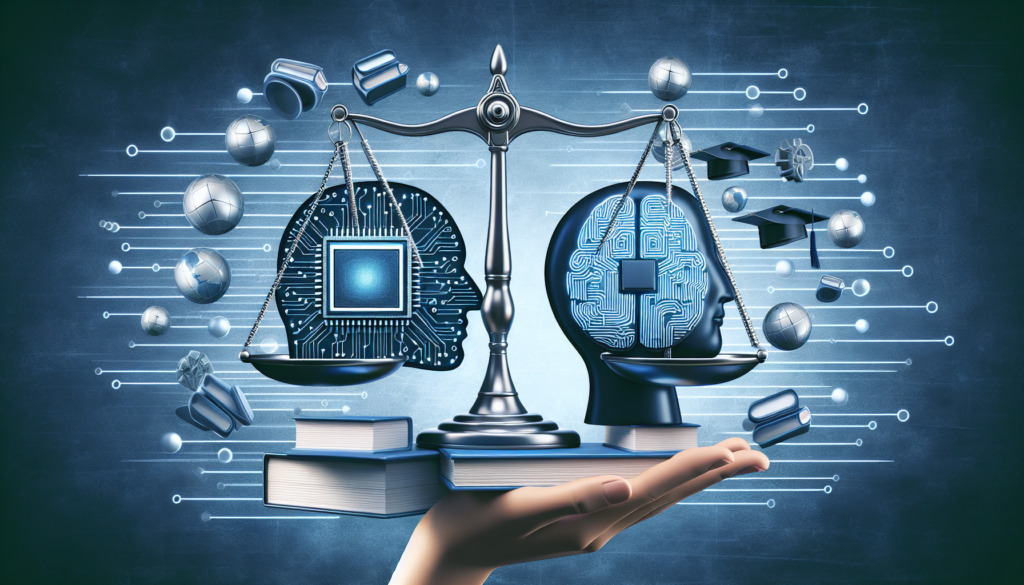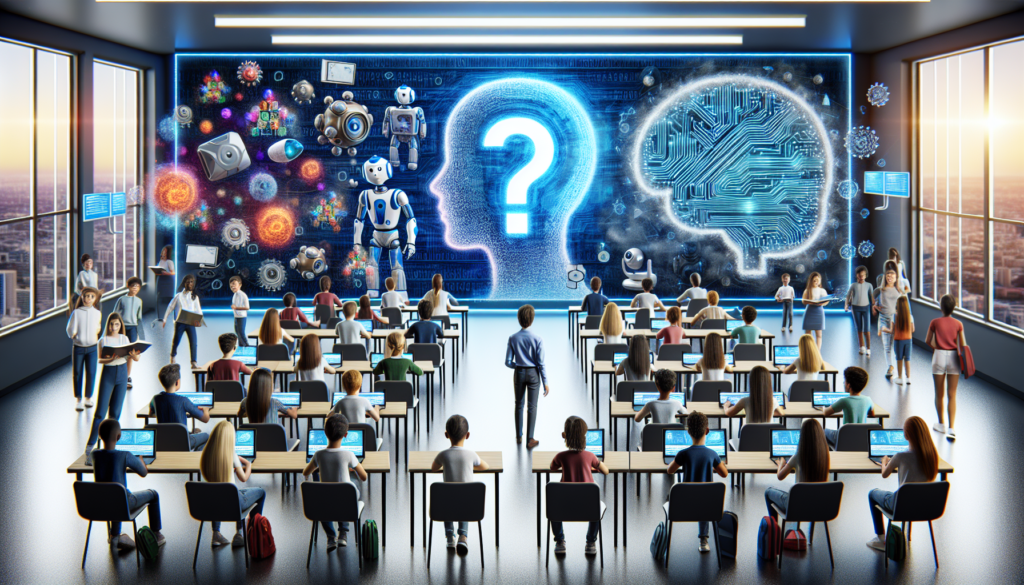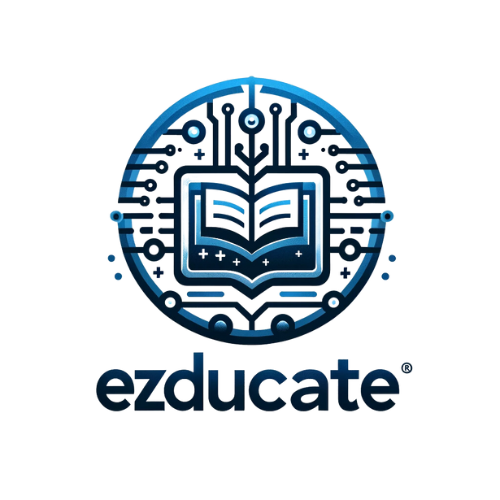As you explore the vast world of AI apps, you may wonder if their contents are truly aligned with educational standards. In a landscape where technology constantly evolves, it becomes crucial to assess whether these AI apps effectively support learning objectives. This article tackles the question head-on, shedding light on the significance of educational standards in the context of AI app content. Let’s delve into this important discussion and explore how these apps can effectively shape the future of education.

Challenges in aligning AI app contents with educational standards
Lack of standardized guidelines
One of the major challenges in aligning AI app contents with educational standards is the lack of standardized guidelines. Education systems vary across different countries and even within the same country, there may be different standards followed by different states or regions. This lack of standardization makes it challenging for developers of AI apps to ensure that their content aligns with the specific requirements of each educational standard.
Diverse educational standards worldwide
In addition to the lack of standardized guidelines, another challenge is the diverse educational standards worldwide. Each country has its own set of educational standards, which may differ significantly from those of other countries. This diversity requires developers to tailor their AI app contents to meet the specific requirements of each country’s educational system. Adapting the content to address the unique needs and objectives of each educational standard adds complexity to the development process.
Variation in app content quality and relevance
Another challenge in aligning AI app contents with educational standards is the variation in content quality and relevance. Not all AI apps that claim to support educational standards provide high-quality and relevant content. Some apps may have outdated or inaccurate information, while others may lack depth or fail to address important concepts. This variation in content quality and relevance makes it difficult for educators and students to find trustworthy and valuable AI apps that meet their specific requirements.
Importance of aligning AI app contents with educational standards
Enhanced learning outcomes
Aligning AI app contents with educational standards is crucial for enhancing learning outcomes. When the content of the app is aligned with the curriculum, it ensures that students are learning the right concepts and skills at the right pace. This alignment promotes a comprehensive and coherent learning experience, leading to improved learning outcomes for students.
Consistency in curriculum delivery
Aligning AI app contents with educational standards ensures consistency in curriculum delivery. By incorporating the specific objectives, topics, and requirements of the educational standard, AI apps can provide a consistent learning experience across different schools and classrooms. This consistency helps to eliminate discrepancies in students’ knowledge and skills and facilitates smooth transitions between different educational settings.
Efficient use of technology in education
Aligning AI app contents with educational standards facilitates the efficient use of technology in education. When AI apps are designed to address the specific requirements of an educational standard, they can effectively support and complement classroom instruction. By leveraging the capabilities of AI, such as personalized learning and adaptive assessments, these apps can enhance teaching and learning experiences, making education more engaging, efficient, and effective.
Current approaches to aligning AI app contents with educational standards
Collaboration with educational experts
One approach to aligning AI app contents with educational standards is through collaboration with educational experts. Developers can work closely with subject matter experts, curriculum designers, and teachers to ensure that the content of their app aligns with the specific requirements of the educational standard. These experts can provide guidance on the essential concepts, skills, and learning objectives that should be addressed in the app, ensuring its relevance and effectiveness in supporting teaching and learning.
Integration of standard frameworks
Another approach is the integration of standard frameworks. Developers can incorporate established frameworks, such as the Common Core State Standards in the United States or the International Baccalaureate Curriculum, into their AI app contents. These frameworks provide a basis for aligning the content with the educational standard and ensure that the app covers the essential concepts and skills required by the standard.
Adoption of adaptive learning techniques
The adoption of adaptive learning techniques is also a current approach to aligning AI app contents with educational standards. Adaptive learning uses AI algorithms to personalize the learning experience based on individual students’ needs, preferences, and progress. By leveraging these techniques, AI apps can tailor the content, pace, and difficulty level to match the requirements of the educational standard and adapt to accommodate students’ varying learning styles and abilities.

Benefits and limitations of aligning AI app contents with educational standards
Benefits of personalized learning experiences
Aligning AI app contents with educational standards can provide numerous benefits, one of which is personalized learning experiences. AI apps that are aligned with the educational standard can adapt the content and pace of learning to suit individual students’ needs, preferences, and learning styles. This personalization promotes student engagement, motivation, and ownership of learning, leading to improved learning outcomes.
Mitigation of bias and inaccuracies
Aligning AI app contents with educational standards also helps mitigate bias and inaccuracies. When the content is aligned with established educational standards, it undergoes a rigorous review process to ensure its accuracy, objectivity, and inclusivity. This review process helps identify and eliminate biases and inaccuracies, ensuring that the content is reliable, unbiased, and reflects diverse perspectives and experiences.
Challenges in adapting to individual needs
However, one limitation of aligning AI app contents with educational standards is the challenge of adapting to individual needs. While personalization is a significant benefit, striking a balance between adhering to the educational standard and catering to individual students’ specific needs can be challenging. Some students may require additional support or have unique learning requirements that may not be fully addressed by the standard-aligned content of the AI app.
Role of AI in evaluating educational standards alignment
Automated evaluation algorithms
AI plays a crucial role in evaluating the alignment of educational standards with app contents through the use of automated evaluation algorithms. These algorithms can analyze the content of AI apps and compare it against the specific requirements of the educational standard. By examining the coverage of topics, skills, and objectives, the algorithms can determine the extent to which the app aligns with the standard and identify any gaps or mismatches.
Leveraging AI for continuous improvement
Furthermore, AI can be leveraged for continuous improvement in aligning app contents with educational standards. By analyzing user data and feedback, AI algorithms can identify areas where app contents may need revision or enhancement to better align with the educational standard. This ongoing analysis and feedback loop allow developers to continuously improve the app’s alignment and ensure its effectiveness in supporting teaching and learning.
Potential of AI in real-time feedback
AI also holds the potential to provide real-time feedback on the alignment of app contents with educational standards. Through the use of natural language processing and machine learning techniques, AI algorithms can analyze student interactions with the app and provide instant feedback on how well the content aligns with the educational standard. This real-time feedback allows educators to make timely adjustments and interventions to ensure that students’ learning experiences align with the expected standards.
Case studies showcasing AI app alignment with educational standards
XYZ app: Customizing content to match local curriculum
XYZ app is an example of an AI app that successfully aligns its contents with the local curriculum. The developers of the app collaborated closely with educational experts, teachers, and curriculum designers to ensure that the content of the app matches the specific requirements of the local educational standards. By customizing the content to align with the local curriculum, XYZ app provides a comprehensive and relevant learning experience for students, enhancing their learning outcomes.
ABC app: Utilizing AI for adaptive assessments
ABC app demonstrates the successful integration of AI for adaptive assessments aligned with educational standards. This AI app uses adaptive learning techniques to personalize assessments based on individual students’ needs and abilities. By aligning the assessments with the educational standard, ABC app ensures that students are assessed on the specific concepts and skills required by the standard, providing valuable feedback to both students and educators.
PQR app: Incorporating national standards in design
PQR app showcases the incorporation of national standards in its design. The developers of this AI app recognized the importance of aligning their contents with the national educational standards and integrated the specific objectives, topics, and requirements of the standards into the app’s design. As a result, PQR app provides a consistent and standardized learning experience for students across the country, ensuring that they meet the expected national standards.
Emerging trends in aligning AI app contents with educational standards
Integration of natural language processing
An emerging trend in aligning AI app contents with educational standards is the integration of natural language processing (NLP). NLP enables AI apps to understand and analyze human language, allowing for more sophisticated interactions and personalized learning experiences. By incorporating NLP, AI apps can align their contents with educational standards more effectively and provide more targeted and contextualized support to students.
Use of machine learning for personalized recommendations
Another emerging trend is the use of machine learning for personalized recommendations. Machine learning algorithms can analyze large amounts of data on students’ preferences, learning styles, and performance to make accurate and personalized recommendations for content and resources aligned with the educational standard. This personalization enhances the relevance and effectiveness of AI app contents, promoting individualized learning experiences.
Integration of virtual reality for immersive learning
The integration of virtual reality (VR) is also an emerging trend in aligning AI app contents with educational standards. VR technology provides immersive and interactive learning experiences, allowing students to explore and engage with educational content in a three-dimensional virtual environment. By incorporating VR, AI apps can align their contents with the educational standard more creatively and provide students with a unique and engaging learning experience.
Challenges and concerns in aligning AI app contents with educational standards
Ethical considerations in data privacy and security
One of the challenges and concerns in aligning AI app contents with educational standards is ethical considerations in data privacy and security. AI apps collect and analyze large amounts of data on students’ learning behavior, preferences, and performance. It is crucial to ensure that this data is protected and used responsibly, respecting students’ privacy rights and complying with relevant regulations and policies.
Potential for perpetuating inequities
There is also a concern that aligning AI app contents with educational standards may perpetuate inequities. Educational standards may not always consider the diverse needs and backgrounds of students, leading to a one-size-fits-all approach that may disadvantage certain groups. AI apps should be designed to address these concerns and provide equitable access and support to all students, regardless of their socio-economic status, language proficiency, or learning abilities.
Balancing standardization and individualization
A challenge in aligning AI app contents with educational standards is finding the balance between standardization and individualization. While it is important to align the content with the educational standard to ensure consistency and coherence, it is equally essential to adapt the content to meet the unique needs and preferences of individual students. Striking this balance requires careful consideration and customization to provide a personalized learning experience without compromising the integrity of the educational standard.
Future prospects and recommendations
Establishment of international standards for AI app contents
In the future, it is recommended to establish international standards for AI app contents. These standards would provide a common framework and guidelines for developers to align their content with educational standards across different countries. By establishing international standards, AI apps can ensure global relevance and facilitate the exchange and adoption of high-quality educational resources.
Investment in research and development
Further investment in research and development is also crucial for improving the alignment of AI app contents with educational standards. Continued research can help identify best practices, effective strategies, and innovative approaches for aligning AI app contents with educational standards. By investing in R&D, developers can enhance the quality, relevance, and effectiveness of AI apps, contributing to improved learning experiences and outcomes for students.
Regular evaluation and auditing of AI apps
Regular evaluation and auditing of AI apps are recommended to ensure their alignment with educational standards. Educational authorities, policymakers, and educational experts should establish processes to evaluate the content of AI apps and verify their alignment with the specific requirements of the educational standard. This evaluation and auditing process should be ongoing to address any changes or updates in the educational standards and ensure that the AI apps provide accurate, up-to-date, and relevant content.
Conclusion
Aligning AI app contents with educational standards is essential for promoting enhanced learning outcomes, ensuring consistency in curriculum delivery, and efficiently using technology in education. While challenges such as lack of standardized guidelines, diverse educational standards, and variation in app content quality exist, current approaches and emerging trends offer promising solutions. The role of AI in evaluating educational standards alignment, case studies showcasing successful alignment, and recommendations for future prospects highlight the importance of continuous improvement and collaboration in this area. As AI continues to evolve, aligning AI app contents with educational standards will play a pivotal role in shaping the future of education and fostering effective and equitable learning experiences for all students.




